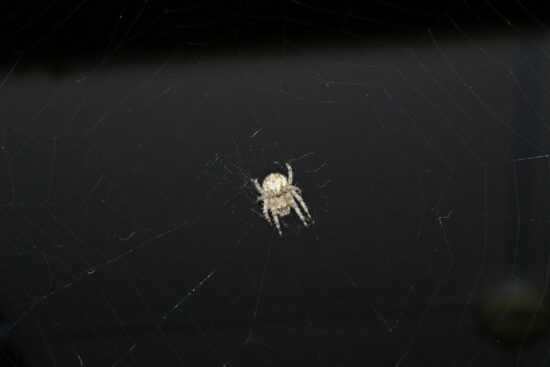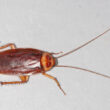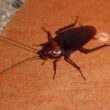Finding spiders in your home can be unsettling, but have you ever wondered what’s attracting them in the first place? The answer lies in understanding what these eight-legged visitors are looking for: their next meal.
Spiders are carnivorous predators, meaning they survive entirely on hunting and eating other creatures. They’re not interested in your leftovers or pantry items. Instead, spiders eat insects and other small pests that might already be living in your house. In fact, research shows that spiders worldwide consume an incredible 400 to 800 million metric tons of insects every single year. That’s more meat and fish than all humans eat combined!
Understanding what spiders eat is actually one of the smartest pest control strategies you can have. When you know what’s on their menu, you can figure out why they’re in your home and what steps to take to keep them out. Let’s look at the eight main types of food that attract spiders to your space.
1. Flying Insects Are Their Favorite Airborne Prey
The most common meals for house spiders are the flying insects that buzz around your home. Houseflies, fruit flies, mosquitoes, moths, bees, and wasps make up a huge portion of what spiders eat on a daily basis. Web-building spiders are especially good at catching these airborne pests. They spin sticky traps in strategic locations where flying insects are likely to pass through. Once a fly or mosquito touches the web, it gets stuck, and the spider rushes over to wrap it up for dinner.
This is why you often see spider webs near windows and doors. These spots get plenty of traffic from flying insects trying to get inside or attracted to your indoor lighting. Outdoor lights are particularly problematic because they draw moths and other flying bugs at night, which in turn attracts spiders to set up shop nearby.
If you’re seeing lots of spiders around your windows or porch lights, you likely have a flying insect problem too. The spiders are just following their food source. Reducing flying insects in and around your home will naturally make it less attractive to spiders. Consider switching to yellow bug lights outside, keeping windows and doors properly sealed, and fixing any damaged screens that let insects slip through.
2. Crawling Insects Make Perfect Ground-Level Meals
While flying insects get a lot of attention, spiders eat plenty of crawling pests too. Ants, beetles, cockroaches, crickets, grasshoppers, and earwigs are all fair game for hungry spiders. These ground-level meals are particularly important for hunting spiders like wolf spiders and jumping spiders. Unlike web-builders that wait for prey to come to them, hunting spiders actively chase down their meals. They have excellent eyesight and can spot a cricket or roach from across the room before pouncing with impressive speed.
The good news? Spiders help manage the population of many insects that humans consider pests. They work around the clock to keep ants from invading your kitchen and cockroaches from multiplying in dark corners. In gardens and around homes, they ensure that pest insects don’t damage plants and crops.
If you’re noticing spiders in your basement, garage, or kitchen, they’re probably hunting the crawling insects already living there. Before you panic about the spiders, consider whether you might have an ant or roach problem that’s attracting them. Solving the underlying pest issue often solves the spider issue too. Keep floors clean, store food in sealed containers, and eliminate the conditions that attract crawling insects in the first place.
3. Other Common Household Pests End Up as Spider Food
Beyond the obvious flies and ants, spiders have a taste for several other household pests that homeowners struggle with. Silverfish, fleas, woodlice, and even bed bugs can end up as spider food. Some spider species have actually specialized in eating specific pests. The aptly named Woodlouse spider, for example, feeds primarily on woodlice (also called pill bugs or roly-polies). These spiders have powerful jaws designed specifically for crunching through the tough exoskeletons of their favorite prey.
Spiders congregate wherever pest activity is high. If there’s a buffet of insects in your attic, basement, or crawl space, spiders will find it and move in. They’re attracted to the same dark, undisturbed areas where many pests like to hide.
Here’s the bottom line: spider presence is often a symptom, not the problem itself. If you’re seeing multiple spiders in your home, it’s a strong sign that you have another pest infestation they’re feeding on. A pest control professional can help identify what insects are attracting the spiders and address both issues at once. This comprehensive approach is far more effective than just killing individual spiders while leaving their food source untouched.
4. Spiders Will Even Eat Other Spiders
Yes, you read that right. Spiders will absolutely eat other spiders when given the chance. This cannibalistic behavior might sound shocking, but it’s actually pretty common in the spider world. Jumping spiders actively hunt smaller spiders as part of their regular diet. They stalk other arachnids the same way they’d hunt any other prey. Web-building spiders also sometimes trap other spiders in their webs, either by accident or on purpose, and then eat them.
Interestingly, some spiders are particularly good at killing species that humans fear. Cellar spiders (those long-legged spiders often called “daddy longlegs”) are known to attack and eat Black Widow spiders. This makes them a surprisingly helpful ally to have around, even though most people don’t want any spiders in their homes. Female spiders sometimes eat their mates after reproduction too. This behavior ensures the female has enough nutrition to produce healthy eggs and support her offspring. It’s brutal, but effective.
Spider-on-spider predation can actually help control spider populations naturally. However, this doesn’t mean you should leave spiders alone if you’re uncomfortable with them. Just know that not all spiders are creating more spiders, and some are actually reducing the numbers. Still, if you’re dealing with venomous species or large populations, professional intervention is the safest route.
5. Larger Spiders Can Tackle Bigger Prey
While most house spiders stick to insects, some larger species can take down surprisingly big prey. Worms, snails, and even small vertebrates like frogs, lizards, birds, and bats have been documented as spider food. The Goliath birdeater, the world’s largest spider by mass, has a menu that includes large arthropods, worms, amphibians, rodents, lizards, and snakes. It hunts at night, pouncing on prey and paralyzing them with venom delivered through its massive fangs.
Before you panic, here’s the reassuring part: these scenarios almost never happen with common house spiders. The spiders you find indoors are relatively small and stick to eating insects. The species capable of eating vertebrates are either exotic pets, found in tropical regions, or live outdoors in the wild. Your average house spider has zero interest in anything larger than a moth.
If you’re dealing with common house spiders like cellar spiders, cobweb spiders, or even wolf spiders, you don’t need to worry about them eating anything besides insects. Their prey preferences remain firmly in the bug category, which is actually helpful for keeping other pest populations under control. Focus your pest control efforts on the insects these spiders are hunting, not on worrying about what the spiders themselves might attack.
6. Some Species Eat Plant-Based Foods Too
Here’s something most people don’t know: a small number of spider species actually supplement their diets with plant materials. Some spiders eat nectar, plant sap, honeydew, leaf tissue, pollen, and seeds in addition to their regular insect meals. This vegetarian side hustle is definitely the exception, not the rule. The vast majority of spiders are strict carnivores that only eat other animals. Even the species that consume plant materials still get most of their nutrition from hunting insects.
One example comes from Central America, where a particular spider species feeds primarily on the leaves of acacia trees. Another has been observed building underwater webs to catch fish. These are fascinating outliers in the spider world, but they’re not the spiders you’ll encounter in your home.
This information doesn’t really change your home pest control strategy. The house spiders you’re dealing with are carnivorous hunters focused entirely on eating insects and other small creatures. They’re not interested in your houseplants or produce. Keep your attention on eliminating the insects that attract spiders rather than worrying about protecting your plants from spider damage.
7. How Spiders Actually Consume Their Prey
The way spiders eat is completely different from how humans or most other animals consume food. Spiders can’t chew or bite off chunks of their meals. Instead, they use a fascinating process called external digestion. Here’s how it works: After a spider catches its prey, it bites down with its fangs and injects venom. This venom serves two purposes. First, it paralyzes or kills the prey so it can’t escape or fight back. Second, it contains digestive enzymes that start breaking down the prey’s insides.
The spider then releases more digestive fluids onto and into the prey’s body. These enzymes turn the victim’s internal organs and muscles into liquid. Once everything inside is properly liquified, the spider uses its mouth like a straw, sucking up the nutritious soup. The whole process can be repeated several times until the spider has consumed everything except the hard outer shell. What’s left behind is essentially an empty exoskeleton that looks mostly intact from the outside. But inside, it’s been completely hollowed out. This is why you might find insect remains in spider webs that look almost normal but are actually just empty husks.
Understanding this feeding behavior helps explain spider activity patterns in your home. Spiders build webs in locations where they can easily catch and consume prey without being disturbed. They need time to inject enzymes, wait for the prey to liquify, and then feed. This is why they prefer corners, high ceilings, and other out-of-the-way spots where they won’t be interrupted during their meals. When you’re looking for spider webs to remove, check these undisturbed areas first.
8. How Often Spiders Need to Eat
One of the most interesting things about what spiders eat is how often they actually need food. The frequency varies quite a bit depending on prey availability and environmental conditions. When insects are abundant, most spiders will eat quite frequently. They can consume food up to four times per day during peak feeding times. This usually happens during warmer months when insect populations are high and spiders can easily catch multiple meals.
However, spiders are also incredibly efficient at surviving without food. They can go weeks or even months between meals if necessary. During colder months when prey is scarce, some spiders enter a state similar to hibernation. They slow down their metabolism dramatically, allowing them to survive on very little food until conditions improve. Spiders get most of their water from the prey they eat, but they do need additional water sources. They tend to hang out near water because it attracts the insects they hunt. Damp basements, bathrooms, and kitchens are particularly attractive to spiders for this reason.
Spiders stick around in locations where food is consistently available. If your home has plenty of insects for them to eat, they’ll stay put and might even reproduce. But if you eliminate their food sources, they’ll eventually move on to find better hunting grounds. This is why controlling other pest insects is so effective at reducing spider populations. No food means no reason for spiders to stay. Use dehumidifiers in damp areas, fix leaky pipes, and maintain proper ventilation to make your home less attractive to both insects and the spiders that hunt them.


